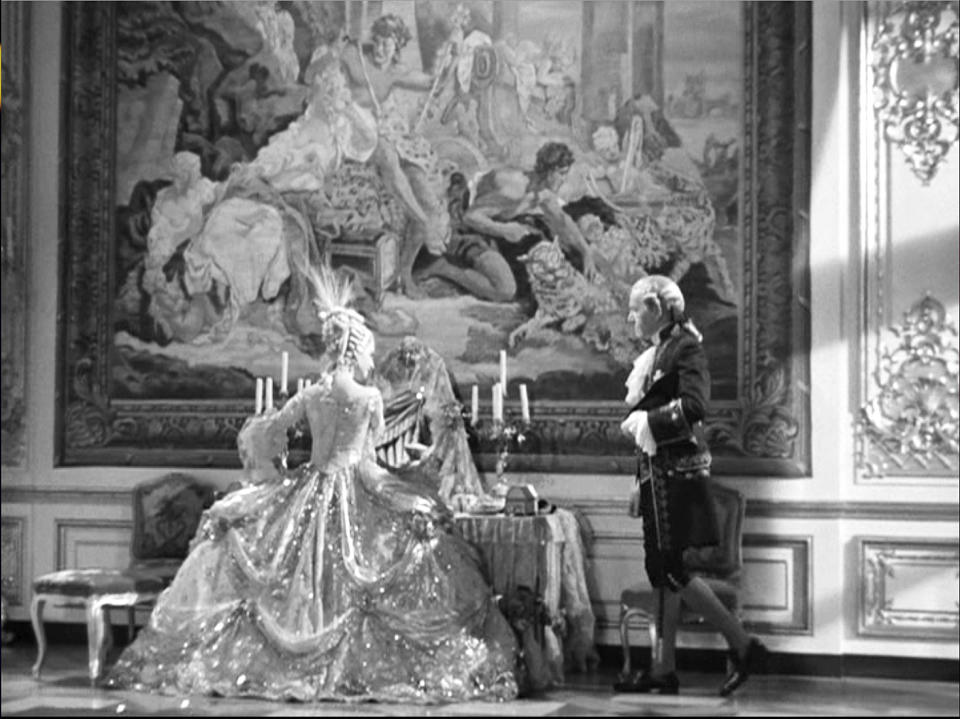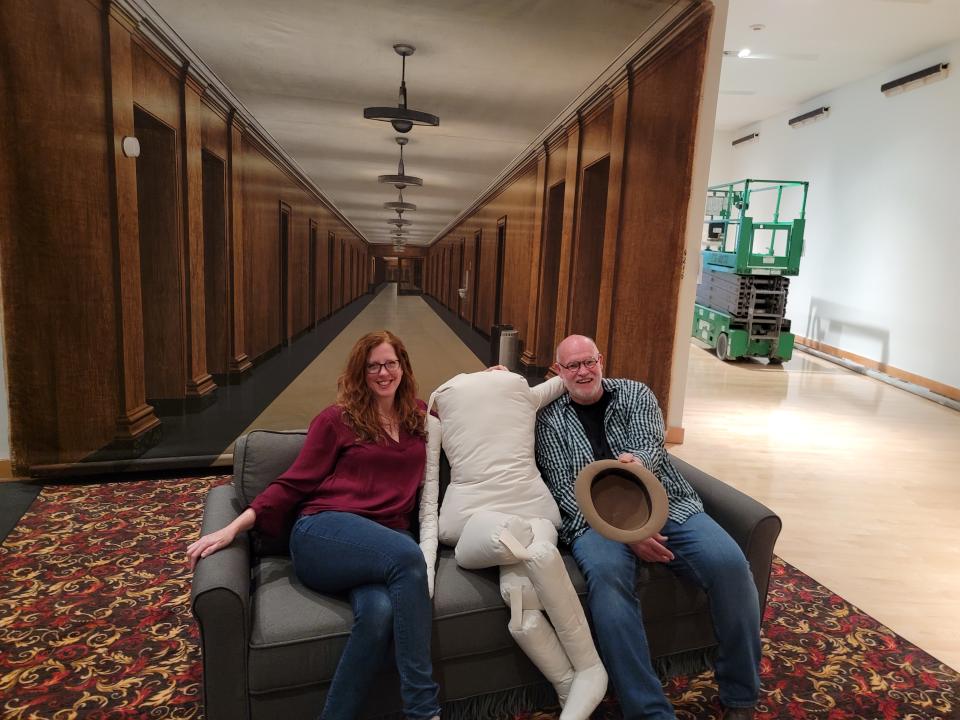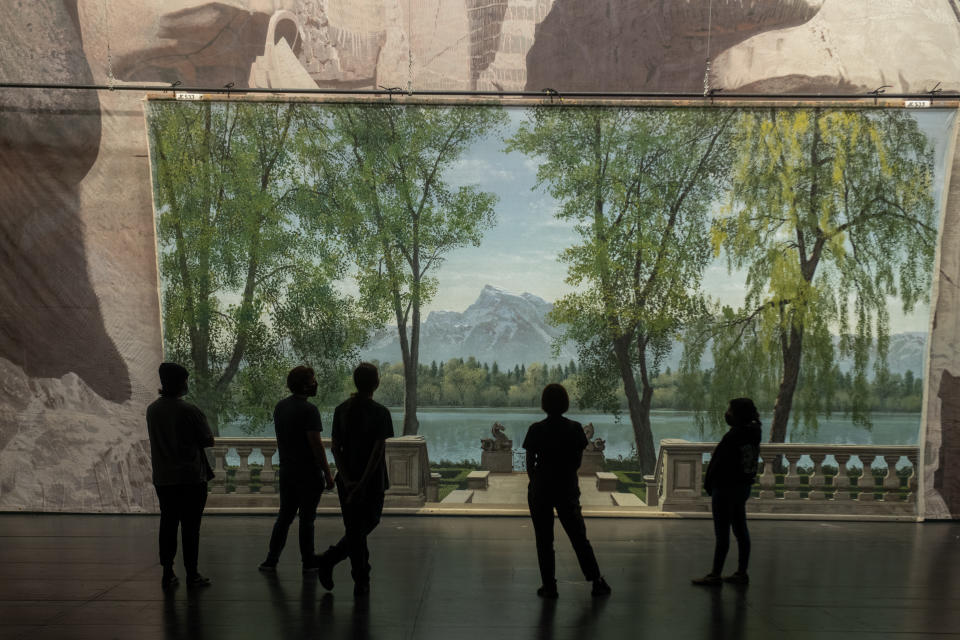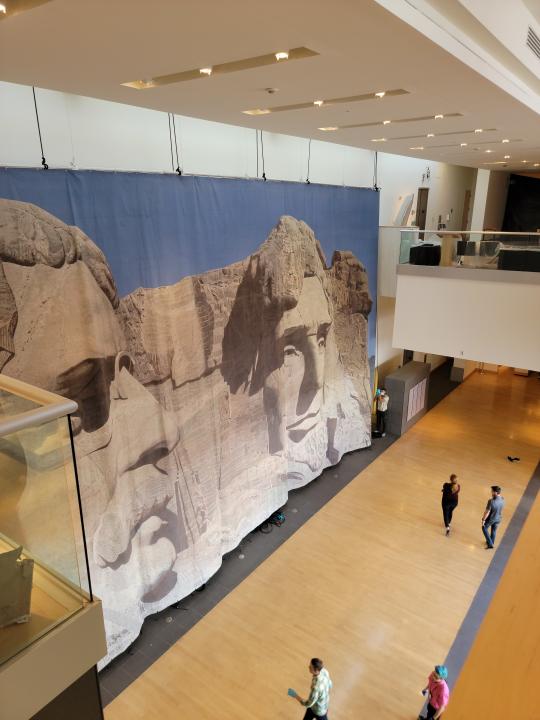Movie Backdrops Move Front and Center in New Museum Exhibit
- Oops!Something went wrong.Please try again later.

Production designer Thomas Walsh quotes a saying well-known to scenic artists and designers: “If you really notice the backdrop, it’s a failed backdrop.”
Mammoth paintings designed to depict everything from Mount Rushmore to an office hallway or an Austrian mountain range may have been created to fool the eye and fade into the literal background in a movie, but now they take center stage in a new museum exhibition that just unveiled in South Florida. Art of the Hollywood Backdrop: Cinema’s Creative Legacy opened April 20 at the Boca Raton Museum of Art and features 22 hand-painted backdrops from classic films that include North by Northwest, Singin’ in the Rain and The Sound of Music, as well as a handful that have yet to be attributed to specific movies.
More from The Hollywood Reporter
How Much Is MGM's Movie and TV Library Worth? Amazon Discloses New Details
Amber Ruffin Co-Written 'Some Like It Hot' Stage Adaptation to Open on Broadway in December
Nehemiah Persoff, Actor in 'Some Like It Hot,' 'On the Waterfront' and 'Yentl,' Dies at 102
The exhibition is the brainchild of museum executive director Irvin Lippman, who was watching CBS Sunday Morning in February 2020 and caught a story that explored a renewed appreciation for the once-forgotten backdrops from many of Hollywood’s golden-era films. The segment included interviews with Walsh and with Karen Maness, assistant professor of scenic design and figurative painting at the University of Texas at Austin and the co-author of a seminal book on the subject, 2016’s The Art of the Hollywood Backdrop. An alumnus of UT Austin, Lippman decided he would try to get in touch with Maness and discern whether the backdrops might work as the subject of their own museum show. “Once I spoke with Karen, it was apparent [that] enough were available to create an exhibition,” Lippman notes.
Like many objects from classic films, most of the backdrops in the exhibition were rescued years ago from forgotten corners and basements in studio buildings, many by J.C. Backings, a Culver City company that specializes in creating backdrops for film and television rental (while they still produce hand-painted backdrops, many of today’s backings are produced on vinyl or as digital art). The firm was founded in 1962 by John Harold Coakley and John Gary Coakley, a father-and-son team with deep ties to the industry: several of their backings are seen in 1965’s The Sound of Music, while John Harold’s father, John Coakley, worked as a scenic artist under the legendary George Gibson, who headed up MGM’s scenic-design department from 1938 to 1968 (Gibson’s first film for the studio was 1939’s The Wizard of Oz, though his Technicolor-friendly backdrops for that film are unfortunately thought to be lost). Over the years J.C. Backings purchased discarded backdrops from MGM, Disney, 20th Century Fox and other studios, in some cases rescuing them from the fate of garbage dumpsters. “Without J.C. Backings, I’m not sure many of these would have survived,” Lippman says.
Walsh agrees. When John Gary Coakley’s daughter and current president of the company, Lynne Coakley, knew they would have to edit roughly 200 backdrops out of their collection when they moved to new headquarters, she called Walsh in New Mexico, where he was working on Netflix’s Longmire, to ask if he knew who might be interested in acquiring them. That conversation led Walsh to create the Art Directors Guild Backdrop Recovery Project, a project in which he, Maness and Coakley photographed and catalogued the to-be-discarded backdrops, hopeful of finding new homes for each. “They determined there were 207 backdrops they weren’t going to take with them, bottom-of-the-pile pieces that weren’t being rented,” Walsh explains. He spent about two years seeking homes for the backings around the globe, diverse locations that ranged from the Academy of Motion Picture Arts and Sciences to UT Austin and the Royal Conservatoire of Scotland in Glasgow, which gratefully accepted five backdrops painted by Gibson, who was Scottish by birth. The scenic designer, whose credits also include An American in Paris and Brigadoon, passed away in 2001.
Fast-forward to 2020, when Lippman was able to reach Maness and offer up his museum’s space for an exhibition. She immediately invited Walsh to co-curate the event. “We knew treasures existed beyond UT Austin’s collection, so we reached out to J.C. Backings with a request to borrow 17 of their backings, including the iconic paintings from Ben-Hur, North By Northwest, and The Sound of Music,” Maness adds, noting that Lynne Coakley’s company quickly agreed — and went one step further. “Astonishingly, they shared that they would prefer the loan to be a donation to UT Austin’s Texas Performing Arts Hollywood Backdrop Collection as teaching assets for future generations under my care and stewardship.”

Boca Raton Museum of Art
Walking through the Boca Raton Museum’s galleries indeed feels like taking a tour through Hollywood soundstages, from a trompe l’oeil painted tapestry prominently used in 1938’s Marie Antoinette to a New York City skyline seen in both 1949’s The Fountainhead and TV’s The Jeffersons and a vast cityscape of ancient Rome, originally painted for 1959’s Ben-Hur and later rented for re-use in the 2016 Coen Brothers film Hail, Caesar!

Boca Raton Museum of Art
Roped stanchions prevent visitors from getting too close, yet this exhibition also represents the first time the public can view such a wide-ranging collection of hand-painted backdrops in person. “We want people to appreciate these works for their artistry,” Lippman says. “We invite you to get an up-close look and appreciate the details and brushstrokes.”
Situated among the backdrops are video screens that tell behind-the-scenes stories about production design, with interviews that include Gibson, who was featured in the 1992 Turner Classic Movies documentary MGM: When the Lion Roars. Next to a backdrop of a grand curved staircase — among the “Unknown Film” pieces sure to set the brains of classic-film fans buzzing about their origins — one wall lists roughly 100 scenic artists responsible for the hand-painted backdrops during Hollywood’s golden era. Unsurprisingly, men’s names dominate the list, though a few women’s names are sprinkled throughout. “One of the reasons we wanted to do this was to bring recognition to those who never got credit for the work they did,” Lippman reasons. “In those days, studios didn’t give onscreen credit to everyone who worked on a film, but these were talented artists who made a real contribution.”

Boca Raton Museum of Art
Among the most popular backdrops for photos among museum visitors, according to Lippman, are a waterfront scene from The Sound of Music and the depiction of an office hallway, seen during Donald O’Connor’s “Make ‘Em Laugh” number in 1952’s Singin’ in the Rain. A green fringed couch and the stuffed cloth mannequin O’Connor used in the scene also have been reproduced for selfie moments. “People love to pretend they’re leaning against the stone railing on The Sound of Music backdrop, or they sit on the couch and pretend they’re Donald O’Connor,” Lippman says. “It’s been fun to watch people enjoy those memories of their favorite films in this way.”
In a late-stage move, Lippman realized an ideal place existed for one of the largest backdrops included in the exhibition: a side view of Mount Rushmore, measuring 30 feet tall by 91 feet, 9 inches wide, used in North by Northwest and painted by Gibson and his team. “As we were developing the exhibition, we realized a perfect spot for this backdrop was right in front of us the whole time,” Lippman says as he gestures across the museum’s vast, two-story lobby. “Of course, we had to tuck it in on the sides to get it to fit in here, but it was really a highlight to watch it go up.” (A smaller Mount Rushmore backdrop from a different angle, also from the 1959 Alfred Hitchcock thriller, currently resides at the Academy Museum of Motion Pictures in Los Angeles.)

Boca Raton Museum of Art
Ultimately, what does Lippman hope visitors will experience from the exhibition? “Many of us grew up with these films, and those memories can be really powerful,” he says. “You see people recognize those moments in favorite films, and that impact is quite special. I’m also hoping younger generations might see something that resonates for them, and it might inspire an appreciation for these films in an audience that hasn’t yet experienced them.”
“Art of the Hollywood Backdrop: Cinema’s Creative Legacy” runs through January 22, 2023; an adjacent exhibition, “Bonnie Lautenberg: Art Meets Hollywood,” features the Palm Beach-based artist’s pairings of film stills with iconic artworks released the same year and runs through August 21, 2022. For more information, visit bocamuseum.org.

